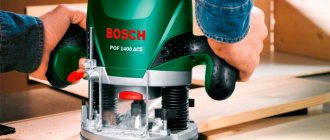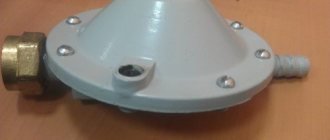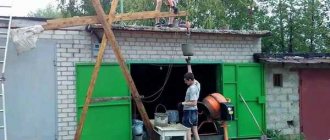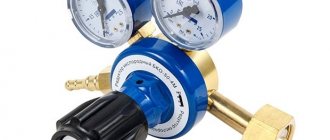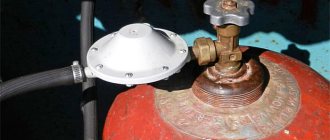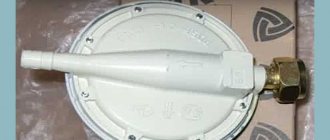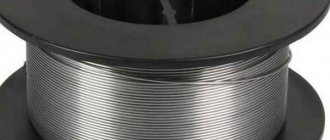Gearbox elements
The carbon dioxide reducer supplies carbon dioxide under a certain pressure. In addition, the same device shuts off the supply of volatile substances when it is necessary to finish welding. Structurally, this device consists of the following elements:
- gas inlet valve and sealing elements;
- chamber with a regulating type membrane;
- gas release valve;
- two types of springs - upper and control;
- fitting for connecting a welding machine;
- frame;
- It is necessary to have two pressure gauges that monitor the pressure of carbon dioxide both at the inlet and outlet;
- shut-off valve.
Color coding
Essentially, a reducer is a pressure regulator for a welding mixture. It is a mandatory part of the equipment for semi-automatic welding machines that use the principle of welding in a protected gas environment. At least two gearboxes (each connected to its own cylinder) are used in a gas welding and cutting installation.
Of course, the best solution would be to choose only a reducer specifically designed for it for a cylinder with a certain gas. There is a strict color coding system:
- blue color with black inscription - oxygen;
- white with red text - acetylene;
- black with blue inscription - technical argon;
- black with white lettering - raw argon;
- black with yellow inscription - carbon dioxide (CO2).
Depending on whether you use gas welding, argon arc welding or carbon dioxide welding, choose the appropriate gearbox.
At the market or in a store, this can be easily done by color - the color of the welding gear matches the color of the cylinder for which it is intended. Blue is for oxygen, black is for argon (also suitable for carbon dioxide), and so on.
Why is carbon dioxide used in a semi-automatic machine?
Carbon dioxide
For metal welding, it is widely used as a shielding gas. It is supplied through a special nozzle in the torch of a semi-automatic machine and reliably protects the welding zone from oxygen and nitrogen in the air, as well as from water vapor.
Interesting materials:
What is the technical correct way to perform a low straight serve in volleyball? How to teleport to a friend in Terraria? How to teleport to private? How does temperature affect enzyme activity? How to stream music to discord from Spotify? How do elephants trumpet? How are Soviet coins valued? How does spinach bloom? How does Twitter count views? How to reduce the bracelet on a watch?
How the device works
It is best to consider the operation of a carbon dioxide reducer using a conventional single-chamber device. Gas is supplied under pressure to the inlet fitting. The incoming substance is controlled by pressure with a pressure gauge installed at the inlet. Getting into the chamber, carbon dioxide puts pressure on the spring, which is pressed down and thereby opens a passage into the chamber cavity. In a carbon dioxide reducer, the cross-sectional area of this section is much larger than the flow area of the fitting, which is why the gas pressure in the chamber is significantly reduced. The pressure drop is recorded by a second pressure gauge, which is considered the output pressure gauge.
Adjusting the device
Adjusting the gearbox for a carbon dioxide cylinder begins with the fact that it is necessary to adjust the tension of the main spring. For this, there is an adjusting screw, and the tension force depends on what initial pressure is observed in the cylinder with the volatile substance. This spring will lower along with the membrane under the influence of carbon dioxide, passing this substance into the chamber to reduce pressure. This chamber is connected to a shut-off valve, as well as a hose through which the gas flow will reach the welding machine torch.
Which carbon dioxide reducer should I choose? When choosing this device, it is very important to pay attention to the fact that the membrane must be made of oil-resistant rubber, and it must also be very accurately positioned relative to the outlet. It is worth adding here that you can use this type of gearbox manually. To do this, you need to screw in or, conversely, unscrew the adjusting screw, based on the pressure gauge readings. Since a sharp increase in pressure in the chamber is possible, the carbon dioxide welding reducer has a safety valve that protects the main membrane from rupture during a sharp increase in pressure. The safety valve will operate at the moment when the adjusting screw for some reason loses its tightness and more carbon dioxide begins to flow into the chamber than expected.
Gas cylinders for propane-butane
Propane tanks are made from either low-alloy or mild-carbon steel. Steel sheets are used in production. A seam runs longitudinally along the cylindrical shell. The lower and upper bottoms are welded to it with circular seams and stamped. A neck is welded to the container on top, and a shoe is welded to the bottom.
Most often, for industrial purposes, propane cylinders are used, designed for 23 kilograms of gas, which corresponds to a volume of 50 cubic decimeters. Together with all the fittings, such a gas cylinder weighs 35 kilograms.
Design features
Today, the main classification of gas reducers for carbon dioxide occurs according to three main criteria:
- The first is the number of working chambers of the device. Today, the majority of devices are produced of a single-chamber type. However, if it is necessary to increase the functionality of the device in conditions of low ambient temperatures, for example, then it is better to use two-chamber devices. The working chambers in such units are arranged in a sequential manner.
- The second point on which the division into classes occurs is working conditions. Today, three main groups are known: ramp, network and balloon. The ramp group of gearboxes is designed for operation in multi-station areas. Network devices require power from a fixed network. Such a network is laid from a stationary station of a carbon dioxide plant. In order to carry out welding work using carbon dioxide and a carbon dioxide reducer for a semi-automatic machine at individual posts, cylinder units are used. However, such devices have lower specific gas consumption, as well as a limited operating pressure range.
- The gearboxes also differ in the principle of opening and closing the inlet valve. These elements can be either direct or reverse. The operating principle of a non-return inlet valve is discussed above, but as for the direct valve, it is much less convenient to use, which is why it is used extremely rarely.
What is the pressure in the carbon dioxide cylinder?
Carbon dioxide cylinders
are accepted for filling both with a working
pressure of
150 and 125 atmospheres, with the exception of 40 liter cylinders for filling 24 kg - this is only for 150 atmospheres.
of the cylinder
is carried out once every five years .
Interesting materials:
How to make sure there are no fingerprints on your phone? How can I prevent them from seeing my posts on the wall? How to make sure you don’t see a person’s story on Instagram? How to prevent calls in messenger? How can I make sure no one sees my VKontakte groups? How to make the wallpaper change itself? How can I prevent emails from going to spam? How can I make a new tab open when I open a website? How can I make the frame appear on one page? How can I make the slides switch automatically?
What to choose
It is believed that for domestic welding conditions - short-term, occasional operations - any device that matches the thread of the cylinder is suitable.
Even a carbon dioxide reducer screwed onto an oxygen cylinder (if gas welding is used) or onto a cylinder for a welding mixture of 80% argon and 20% carbon dioxide can withstand an operation like welding a barbecue for a summer house. Another thing is that later this mechanism will have to be thrown away.
A typical example of such a gearbox designed to work with CO2 is the very well-known and popular among old-school welders UR 6-6.
It is compact, inexpensive, and thanks to the presence of two pressure gauges, it makes it quite convenient to determine the flow rate “by eye.” For household welding, high precision is not needed. One pressure gauge shows the residual pressure in the cylinder, and the second is aimed at demonstrating gas flow - liters per minute.
Oxygen and argon welding regulators are theoretically interchangeable. In this case, oxygen will work worse as the pressure in the cylinder drops to a critical point of about 1 atmosphere.
An example of an argon gearbox for welding is the domestically produced AR-40-2. There is also a truly universal pressure regulator - AR-40/U-30 (argon reducer/carbon dioxide). It will withstand both temperature changes and high pressure.
If there are no financial restrictions, and the volume of welding work is expected to be high, then you should prefer a device not with an additional pressure gauge, but with a rotameter.
The rotameter shows the flow rate of the gas mixture much more accurately, since it works on different principles - it takes measurements in real time. These devices are used by professionals.
For normal gas welding, the main equipment of the welding station is equipped with devices that provide a decrease and subsequent stabilization of the pressure of carbon dioxide coming from the gas cylinder. In our case, such a device is a carbon dioxide reducer. We'll talk about choosing a good gearbox and its correct configuration.
Is interchangeability possible?
Some types of welding gears are interchangeable, but not all. So, instead of a specialized CO2 reducer for welding, it is permissible to use an oxygen one, but a reverse replacement is absolutely forbidden.
Oxygen is a chemically active substance, a strong oxidizing agent, so special metals and alloys are used to work with them. In addition, oxygen is pumped into gas cylinders under pressure that exceeds the same parameter for carbon dioxide by more than 2 times.
A welding reducer for carbon dioxide screwed onto an oxygen cylinder can last, depending on its quality, from several hours to a couple of weeks. But the sealing membranes, the main structural element, will inevitably be completely destroyed, as a result of which the device will begin to etch.
To avoid erroneous actions by the welder, different threads are made on gearboxes for flammable and non-flammable gases. For flammable - left, for non-flammable, respectively, right.
Similar threads are found in cylinders for cutting and welding. In this case, the oxygen reducer has a right-hand thread. Oxygen does not burn on its own, but supports combustion. It is explosive under certain conditions.
The oxygen reducer used during welding with a carbon dioxide cylinder faces another threat. Carbon dioxide causes parts in contact with it to freeze to -60 °C. Since the pressure regulator designed for oxygen is not supposed to withstand this operating mode, it will also begin to deteriorate.
Requirements for devices
Despite the fact that the design features of the equipment are very similar, higher operational requirements are imposed on oxygen reducers. The difference is that O2, unlike CO2, does not liquefy. Due to the absence of this effect, the pressure in an oxygen cylinder reaches 200 atm, while liquefied carbon dioxide is characterized by a maximum pressure of 70-80 atm. Because of this difference, if you install a carbon dioxide reducer on an oxygen cylinder, gradual destruction of the sealing membrane will occur. For this reason, such a replacement is not allowed, however, it is possible to carry out the replacement in the reverse order, that is, installing an oxygen reducer on a carbon dioxide cylinder.
Another significant difference lies in the method of joining. Carbon dioxide gearboxes can be secured using a clamp, while oxygen gearboxes can only be secured using a union nut. This requirement is justified by the fact that with a CO2 leak there is no danger of an explosion or fire, as with an O2 leak. Another small but important design difference is the cleaning filter found in carbon dioxide reducers. The filter is designed not only to purify the gas, but also to prevent the gas from bleeding back into the cylinder, where a surface cushion of gas that has left the liquefied state can form.
What is the difference between an oxygen reducer and a carbon dioxide reducer?
Gas-cylinder equipment belongs to the high-risk class. When performing work using such devices, you must know the rules and comply with the necessary safety regulations. Otherwise, there is a real danger to health and life.
There are various gas-cylinder equipment that provide a protective and auxiliary function during operation, these include gearboxes. Depending on the scope of application and design features, they can be oxygen or carbon dioxide.
Oxygen reducer, its features
A device that is designed to regulate or reduce the gas that comes from a certain container, such as a cylinder, to the required regulated level is called a reducer.
It must also ensure a stable workflow if it is located on a gas pipeline or ramp.
Oxygen reducer - device
An oxygen reducer is used to maintain operating pressure in a cylinder or gas pipeline, despite pressure drops up and down. This unit plays a huge role and is of significant value for the safety of gas equipment. Its design makes it possible to evaluate the correct operation of the entire system. If this unit is not installed, it is quite possible to get a “locking effect”.
This condition means that the gas will begin to flow out in a very fast flow and the speed of its movement can reach the speed of sound, and the cylinder will begin to vibrate and move along the surface.
The oxygen reducer has a fairly simple design and consists of:
- High pressure chambers.
- Chambers with working pressure.
- Connecting valve.
- Pressure gauges for each chamber.
Technical parameters are indicated in the marking and indicate:
- “C” is a network unit.
- "R" - ramp device.
- “B”-balloon device.
The scope of application of oxygen reducers is quite wide:
- When carrying out welding work using cylinders, in order to avoid interruption of the gas supply, the quality of which is responsible for the result of the work.
- In medical institutions, the device provides an uninterrupted supply of oxygen to patients who are under anesthesia and connected to mechanical ventilation.
- In aviation, an oxygen reducer ensures the supply of oxygen to passengers.
Carbon dioxide reducer, features
A device that automatically
reduces the pressure of carbon dioxide inside and regulates the correct supply and stable pressure at the outlet is called a carbon dioxide reducer. This device is designed for installation on gas cylinders. The gearbox can close the release valve shutter in case of termination of work.
Carbon dioxide reducer
The carbon dioxide gearbox structurally consists of:
- Valve and seat with sealing elements.
- A membrane with a solid center in a special chamber.
- A spring element acting on the inlet and outlet valve.
Carbon dioxide gearboxes have many applications:
- Welding processes are carried out in the presence of a carbon dioxide reducer, if the cylinders are filled with carbon dioxide.
- Production direction of synthetic products.
- Chemical production.
- In the food industry, in the production of fizzy (carbonated) drinks.
- In the medical field, during certain types of surgical interventions.
- In the water supply system, carbon dioxide removes alkaline deposits.
- In agricultural practice to provide additional heat in greenhouse structures.
- In the production of paper and pulp, where it is necessary to replace sulfuric acid as a binder component.
Reducers are needed almost everywhere where cylinder equipment with carbon dioxide is used. The purpose of the reducer is to control the gas supply process and stabilize possible pressure drops.
The difference between an oxygen reducer and a carbon dioxide reducer
These two types of reducers have one thing in common: they are designed to regulate pressure when supplying gas. There are differences in purpose, popularity and design . Thus, reducers differ in the diameter of the exhaust valve nozzle and the size of the storage chamber. Also, oxygen reducers are used more often, since oxygen, as a gas, is more in demand in industry.
The oxygen reducer has 2 monometric devices, while the carbon dioxide reducer has one. In addition, there is a difference in the metal and materials from which the gearboxes are constructed. In order for the device to serve for a long time, it is imperative to select the correct reducer for the type of gas used; failure to comply with this rule can be dangerous.
vchemraznica.ru
CO2 welding technology
When everything is ready and configured for semi-automatic gas welding, you can begin. First you need to prepare the metal parts that need to be soldered. The key to a quality seam is preliminary preparation. In order for the material to fuse perfectly, the workpieces must be cleaned of oil, dirt and paint residues. This can be done with a wire brush or sandpaper. After this, the parts are installed in the position in which they will be connected. It is best to make the first seam at low current to see how the workpiece behaves. If you immediately apply a large current, there is a risk of cracks and deformation of parts.
Semi-automatic gas welding can be performed using the following methods:
- forward angle (from right to left) is used for thin sheet metal;
- at an angle back (from left to right) provides deep penetration, but the seam will not be wide.
When the seam is completely ready, you cannot immediately turn off the gas supply, as this is fraught with oxidation. First the wire supply stops, then the current supply, and then the gas supply. Just during this time the seam has time to crystallize. Upon completion of the work, you need to knock the slag off the seam.
What functions does the gearbox perform?
Mechanical gearbox
(from Latin reducere - to reduce), - a mechanism for transmitting power by rotation, the main
function
of which is reduction, that is, reducing the force required to drive the device that converts the transmitted power into useful work.
Interesting materials:
How much does a plane ticket to Germany cost? How much does a ticket to Japan cost? How much does a ticket to South Korea from Novosibirsk cost? How much does a ticket to a comedy club cost? How much does a metro ticket cost for a day? How much does a ticket to Sochi Park 2022 cost? How much does a ticket to Sochi Park 2022 cost? How much does a ticket to Sochi Park cost in summer? How much does a ticket to Tashkent Istanbul cost? How much does a child ticket to Sochi Park cost?
Features of the device UR 6-6
This model has certain features that make it so popular:
- Firstly, the body of this device is made of a special alloy, which provides a certain resistance to various thermal influences and mechanical loads.
- Secondly, the minimum pressure unevenness does not exceed 0.3.
- A fairly low pressure indicator is 1.2 MPa, at which the safety valve will operate.
- Like other devices, it has two pressure gauges, which greatly simplifies the process of adjusting gas pressure.
- The throughput capacity of this type of gearbox is much higher. It is capable of passing up to 6 m3 of gas per hour.
- The cost of this device is about 1,100 rubles, while BUO-5-4, for example, costs 1,700-1,800 rubles.
Despite such differences, the process of selecting a gearbox is quite simple, since there is not much difference between them if you do not have to weld or cut metal at low temperatures. Any device is suitable for working in moderate conditions.
Choosing a gearbox for welding | DIY welding
If you need to buy a gearbox for gas-flame processing, it would be advisable for you to familiarize yourself with GOST 13861-89, where everything is described in detail. Therefore, there is no need to dwell on this issue in detail and rewrite the requirements of the state standard; it is enough to simply download it from the Internet.
It is only worth noting that the marking contains encrypted information necessary for the buyer, which contains all the characteristics:
• purpose (cylinder, network, ramp) • type of gas being reduced • number of stages and method of setting pressure. • maximum throughput in m3/h
For example, the propane reducer BPO-5-5 is a balloon reducer, designed to reduce propane pressure, single-stage with spring regulation, and can flow no more than 5 m3/hour.
There is also a version BPO-5-3-BM without a pressure gauge, which greatly affects the cost - it is half the price.
Regulators for arc welding in an active/inert atmosphere are also divided according to the type of gas used, for example:
• for carbon dioxide UR 6-6 (carbon dioxide) • argon AR-40
Universal devices designed for Ar/CO2 are especially popular. The universal gas flow regulator U30/AP40 with 2 rotameters is used when during welding it is necessary to blow argon through the seam from the reverse side.
When operating in the cold season, especially when carbon dioxide is required as an active medium, which itself, upon expansion, acquires a low temperature, freezing of the gearbox is observed, as a result of which its operation is disrupted. There are special PEG-3 type heaters for semi-automatic and fully automated welding, which you will have to purchase separately. Although there are also regulators on sale that combine all the necessary functions and devices, such as the universal U30-AR40P-220 (Ar/CO2) with a 220V heater - an ideal option for your electric gas welding station.
svarka-master.ru
Characteristic
- Oxygen - designed to regulate the supply of oxygen in the cylinder. Common markings: SKO - 10-2, BKO - 50 mini, RK-70, RKZ - 500-2. Painted blue, secured with union nuts. Capacity from 10 to 500 m3/hour. The price varies from 1600 to 21500 rubles.
- Propane - regulate the supply of propane. Markings: BPO - 5, SPO - 6, RDSG-1-MTL (frog). Painted red, secured with union nuts. Throughput from 1.5 to 1.6 m3/hour. Price - from 400 to 1600 rubles.
- Carbon dioxide - to regulate the supply of carbon dioxide. Markings: UR-6-6, BUO-5-4. Can be painted black or red and blue. Fastened with union nuts. Capacity 5-6 m3/hour. Price 900-1500 rubles.
- Acetylene - regulate the supply of acetylene. Markings: BAO-5-4, RAO-30-1, SAO - 10. Fastened with clamps. Painted white. They pass from 5 to 30 m3/hour. Price from 1600 to 14300 rubles.
- Argon. Markings are: AR-40-4DM, AR-40-KR1-mr. Color white or black. They pass 1.8-5.4 m3/hour. Price 1400-1750 rubles.
- Helium. For helium regulation. Marked: G-70-KR1, G-70-KR1-m. Fastened with nuts. Color white or black. Bandwidth 4.2. Price about 1500.
throughput (highest value) m3/h
gas pressure at the inlet, (maximum value) MPa (kgf/cm2)
operating gas pressure, (maximum value) MPa (kgf/cm2)
For normal gas welding, the main equipment of the welding station is equipped with devices that provide a decrease and subsequent stabilization of the pressure of carbon dioxide coming from the gas cylinder. In our case, such a device is a carbon dioxide reducer. We'll talk about choosing a good gearbox and its correct configuration.
Reducer with heating for carbon dioxide
Today there are gearboxes from the manufacturer DINCONTROL, for example, the main difference of which is the presence of a heating system. These devices are designed not only to reduce gas pressure, but also to automatically control carbon dioxide consumption. In addition, the equipment has a float-type rotameter and a gas heater. The presence of these elements ensures precise adjustment of gas flow, as well as precise control of welding operating time. In order to power the heater, a 24 VAC power supply is required.
The housing for such devices is made of very high-quality metal, namely high-quality brass. The equipment is capable of ensuring safe operation with gas, the pressure of which will not exceed 200 bar. The gearbox cover is corrosion resistant and the inside is zinc coated. The presence of a rotameter on the device will allow you to detect even the slightest gas leak from the cylinder. There is also a safety valve that cannot be adjusted. It is configured for passive gearbox protection. Thanks to high-quality parts, the device can be used in a wide variety of climatic conditions. The operating temperature ranges from -30 to +60 degrees Celsius.
Common misconceptions when choosing a gearbox for welding work (argon, carbon dioxide)
Henry Ford once said: “There are no bad cars, only people who made the wrong choice.” Let's talk today about how to choose a gearbox for semi-automatic or automatic welding in shielding gases and make this choice correctly.
Misconception #1
The problem is that many welders choose the UR-6-6 gearbox. Why is he bad? It was originally developed for the food industry back in Soviet times, i.e. it was used for carbonating water, all kinds of drinks, and for preserving sausages, meat, shrimp and other products. Today there is a whole line of gearboxes that are designed directly for welding in shielding gases, for example:
- Universal AR-40/U-30
- For argon AR-40-2
- For carbon dioxide U-30
Or their analogues.
The main feature of these reducers, in contrast to the UR-6-6, is the presence on the low-pressure pressure gauge of a calibration in l/min for each type of gas. This is very convenient for work; you will no longer need to adjust the flow rate by eye, approximately, or look at the tables, as on the UR-6.
Misconception #2
When choosing a small-sized gearbox for regular use when welding in shielding gases, which is not intended for daily use and 100% load. “Small-sized” ones, if used in industry, will not last long. For constant operation, use large-sized gearboxes with a higher-quality reducing unit that can withstand long-term mechanical and temperature loads, more accurately maintain the specified pressure and flow rate, and accordingly, gas losses in such a gearbox will be smaller.
Misconception #3
Many welders think that rotameter gearboxes are more economical than those with gauge flow indication. Actually this is not true. The consumption is the same. The only difference is that the flow rate with a rotameter is measured and displayed in real time, while a gearbox with a pressure gauge shows the flow rate indirectly, i.e. in accordance with the flow washer and the calculated scale in l/min marked on the low pressure gauge.
Misconception #4
Some welders think that gearboxes with two rotameters are designed to connect two welding stations. In fact, they are used for welding reactive materials such as titanium, because when welding titanium, the weld must be protected on both sides. Such protection is also useful when welding critical stainless steel components. A burner is connected to the first rotameter, through which gas is supplied to protect the weld pool, and to the second - a hose through which gas is supplied to the back side of the seam.
Misconception #5
Application (to save money) instead of a specialized reducer, for example, an oxygen or food reducer. This cannot be done, since the latest devices are not designed for welding in shielding gases. Especially when working in a carbon dioxide environment, they will constantly freeze and fail, which threatens the loss of carbon dioxide or argon, which are quite expensive. Therefore, instead of saving, you will lose.
Misconception #6
Do not use heaters when working with carbon dioxide. Carbon dioxide has a high expansion coefficient, so during its evaporation from the cylinder and reduction, the temperature at the reducing valve can drop to -60 degrees. Moisture, which is quite abundant in this gas, crystallizes, which can lead to failure of the gearbox, which in turn will lead to either a cessation of gas supply or its gravity flow. All this will affect the quality of welds.
Use heaters when working with carbon dioxide. They are:
- Flow type
- Built-in on the inlet fitting
- Built-in (we do not recommend purchasing this type)
Misconception #7
Having purchased a gearbox with a rotameter, some welders try to remove the housing and adjust the set screw or valve. There is no need to do this. Everything is already configured by the manufacturer. Your task is to install the control device on the cylinder and connect it to the welding machine.
svarka-master.ru

